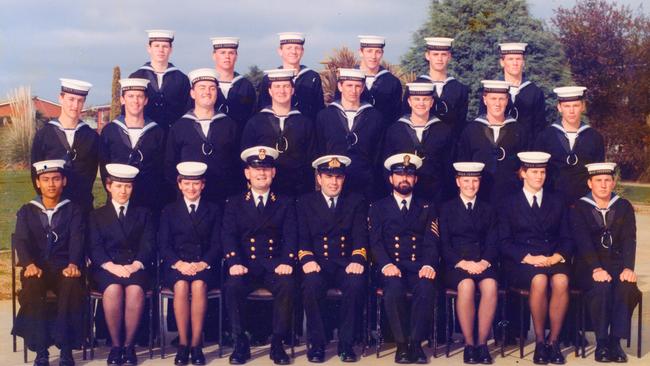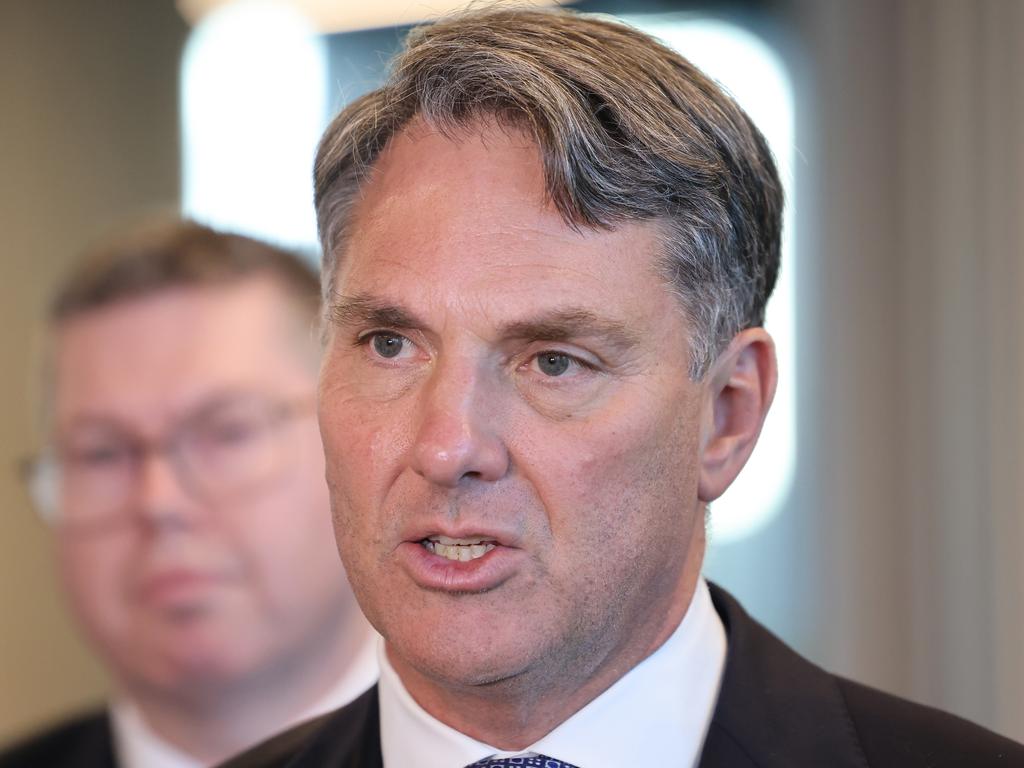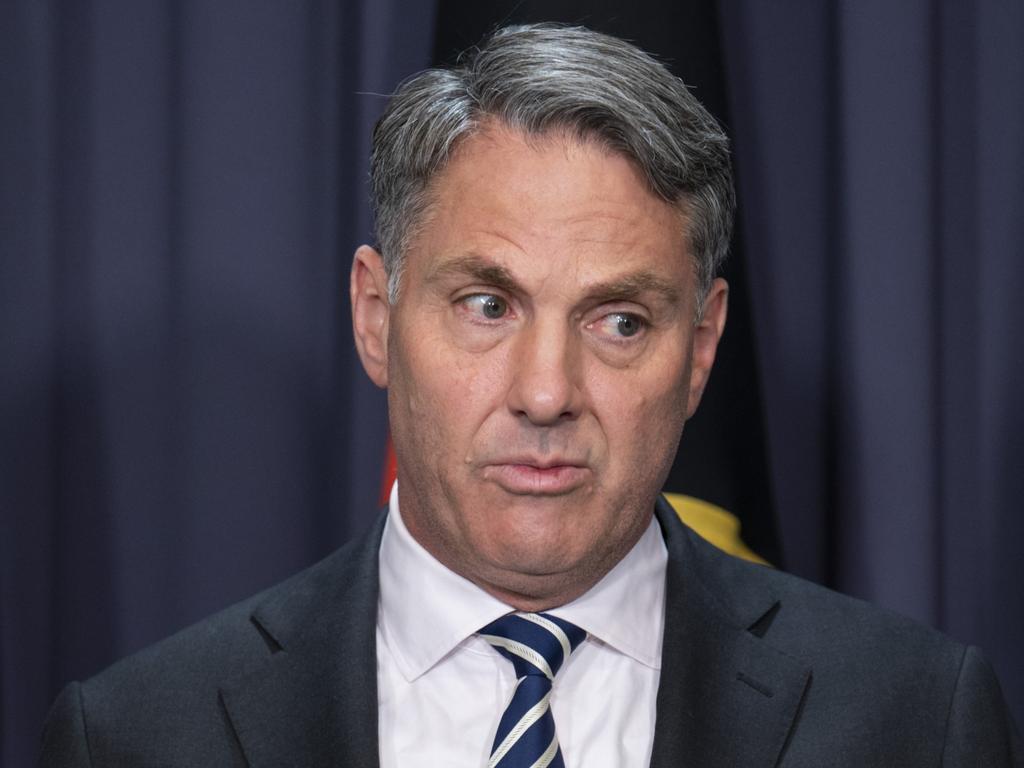Submariner Mark Hammond rises to the challenge
As Australia’s Chief of Navy, Mark Hammond is the right man for the moment.

In 2006, the commander of Collins-class submarine HMAS Farncomb visited then-defence minister Brendan Nelson’s parliamentary office carrying a locked briefcase.
At the time, the navy was bleeding submariners to the mining industry and the Collins boats were under fire over reliability and noise problems.
From the briefcase, the commander produced a sheaf of “extraordinary” photographs taken through the boat’s periscope during surveillance operations.
“They were obviously highly, highly classified, and reflected the professionalism and also the courage of the submarine crews,” Nelson recalls.
He was so impressed, he wrote a letter to every member of Farncomb’s crew thanking them for their courage.
The commander who brought Nelson the photos, Mark Hammond, is now Australia’s Chief of Navy. Vice-Admiral Hammond, 54, is only the second submariner to lead the Royal Australian Navy in its 121-year history.
He tells Inquirer he is a “naval officer first, submariner second”. But, as the nation grapples with the immense challenge of acquiring nuclear-powered submarines, the new chief may just be the man for the times.
Hammond says his role is not to tell the government how to spend its “finite bucket of national treasure” on this capability or that, but to protect the nation’s interests with the vessels and the people that he has.
“My job is to make sure that we meet the expectations of the Australian people and the Australian government, day in, day out, and frankly, make Australia proud,” he says.
“My priority, it won’t surprise you, is the safety and wellbeing of our people. As a submariner, that’s always our highest priority. You take care of your people and they’ll take care of the mission.”
Hammond takes the helm at a critical time, as Defence takes its first steps towards nuclear propulsion and a high-level strategic review examines how the nation should respond to urgent security challenges.

He will prepare for the “life-of-type extensions” of the Collins-class submarines to extend their lives for another decade, and be an important internal voice on addressing the “capability gap” between their retirement and the eventual arrival of nuclear boats.
He is intensely focused on getting the most out of all of the navy’s vessels, and will keep a close eye on the progress of the troubled $45bn Hunter-class frigate program. Training and holding on to enough people to crew the vessels in the tightest jobs market for a generation is also a pressing challenge.
And all the while, tensions are growing in the South China Sea, where freedom of navigation operations and surveillance missions place the Australian sailors on the front line of a potential great power conflict over Taiwan.
It’s a region Hammond knows well. As commander of HMAS Farncomb, nearly all of his operational deployments were in the South China Sea.
Appointed by Defence Minister Richard Marles in late June, Hammond is still in his first 100 days of “listening and learning”.
“You’ve got to understand your inheritance in the context of today, and that context is pretty dynamic,” he tells Inquirer.
Hammond was a skinny 18-year-old from a working class Adelaide family when he decided to join the navy.
At HMAS Cerberus in Victoria, he struck up a friendship with another recruit, Damien Humphreys, who was bunking in the room next door.

The pair made a pact to become submariners together, but Hammond was identified as officer material and departed for the Australian Defence Force Academy, later commencing his career in surface ships.
Humphreys, nicknamed “The Bear” for the children’s television character Humphrey B. Bear, urged him on graduation day in 1986 to “remember The Bear when you’re wearing those gold stripes”.
The following year Humphreys died, the victim of an accident on Oberon-class submarine HMAS Otama, which submerged off Sydney Harbour while he and another young sailor were outside the pressure hull fastening its towed sonar array.
As Hammond tells Inquirer: “It was appalling weather, the crew was in a hurry to get underwater, and there was a systemic procedural problem that existed in our submarine force and many other submarine forces that was exposed on that day and unfortunately cost them their lives.
“At that point, I thought a career in submarines was always where I was going to end up.”
The navy chief has carried the photograph of his and Humphreys’ 1986 recruit class wherever he has been posted, on land or at sea.
Today it sits prominently on the sideboard of his office in Defence’s Canberra headquarters, near the miniature version of the Victoria Cross awarded posthumously to navy war hero Teddy Sheehan, and a photo of Hammond and his wife Jodi – a former ballet dancer who now works at the Australian War Memorial.
Several books are also on display, including Robert F. Kennedy’s Thirteen Days: A Memoir of the Cuban Missile Crisis, David Wilkinson’s The Ambiguity Advantage, and The Little Golden Book of Submarines, “which every kid should have, in my humble opinion”, Hammond quips.
Hammond’s framed copy of Nelson’s letter sits close by, along with a periscope photograph of American aircraft carrier USS Kitty Hawk during a joint exercise, unaware it had just fallen victim to HMAS Farncomb.
Nelson got to know Hammond and his wife well after he retired from politics, working with Jodi when he was War Memorial director. He says the new chief is “clear-minded, intensely ethical”, and has great respect for others.
“The lowest rating in the Royal Australian Navy is not getting any less respect from him than his deputy,” Nelson says. “He’s someone who has got an immense respect for every job that is done by everybody.”

Nelson says the fact that Hammond is a submariner is “a good thing for the Royal Australian Navy at this moment”.
“But he is a chief of navy for the whole navy. In fact, very recently, I spoke to him about the job being done by the young sailors in patrol boats, and he was no less focused on that than he is on submarines.”
The navy has overcome its dire workforce challenges of the early and mid-2000s, when ships and submarines were unable to put to sea because there weren’t enough sailors to crew them.
But now it must look to the future. The submarine force will have to expand from its current 850 sailors to about 2500 to crew the promised nuclear boats, and thousands more will be needed to crew new surface ships.
But Hammond is optimistic new recruits will be found.
“I think we’ve actually got a really good brand, and frankly, having done this for 36 years, there’s not much that’s more rewarding in my view, than getting out of bed, and putting on Australia’s uniform,” he says.
He also raises the prospect that the navy will import talent from overseas.
“I think a lot of them will be homegrown, but not all of them. We won’t go poaching them, but when you look at the lifestyle that we have to offer here – they’re only human.”
Hammond holds a bachelor of science, a masters in management, and a masters in maritime studies, and comes to the top navy job after key roles in Australia and overseas.
He was Australia’s assistant naval attache in Washington, DC, for three years, and served for a year as liaison officer to US chairman of the Joint Chiefs of Staff, General Joseph Dunford, during the first year of the Trump presidency.
He is also close to the US Deputy Chief of Naval Operations for Operations, Plans and Strategy, Vice-Admiral William Merz, and counts retired US chief of naval operations John Richardson as a close friend and mentor.
His links to key powerbrokers in the US naval system will amplify his voice and influence in Canberra as Australia shoots for unprecedented access to America’s nuclear secrets.
“I think the learnings that I’ve picked up along the way from that tapestry of senior leaders … is a bit of a capability advantage that I hope to leverage, politely and appropriately, to set the conditions for our navy’s success,” Hammond says.

“Probably I’ve got a better insight, I think, than some, of what it takes to build the kind of submarine force we’re going to need; that we’re intending to build.”
Hammond has served in one way or another on five of Australia’s six Collins-class submarines, needing time only on HMAS Rankin to complete the flush.
He knows the boats inside out. The Collins-class submarines first entered service in 1996 and, with their early problems overcome and extensive upgrades scheduled, will remain in service until the mid-2040s.
Despite former defence minister Peter Dutton’s warning that conventional submarines will be “easily detectable” by 2035, Hammond insists the Collins boats remain fit for purpose.
“Let me state right now, the Collins-class submarine is one of, if not the most, capable conventional submarines on the planet,” he says. “It has the exact same combat system and torpedo system that is deployed on the Virginia-class submarine.”
The submarine “is capable of and routinely operates in some of the most challenging and congested areas on the planet, including this year”, he says, referring to the South China Sea.
Aside from the Collins, Hammond has been to sea on US, British and French nuclear attack submarines, Dutch conventional submarines, and multiple surface vessels.
He dismisses the suggestion that submarines will become obsolete anytime soon through the deployment of multitudes of underwater sensors or some yet-to-be developed satellite technology that might “lift the veil of the sea”.
Hammond says the Chinese must be equally confident that submarines will retain their stealthy advantage, or they wouldn’t be building them at a faster rate than any other nation.
“While there will be incremental improvements in technology for anti submarine warfare, there are equally improvements in technology that go into the submarines. And I’ve watched this dance now for decades.
“That operating environment below the surface is still one of the most opaque and most difficult to penetrate.
“And I think that’s going to continue to be the case for a while.”








To join the conversation, please log in. Don't have an account? Register
Join the conversation, you are commenting as Logout